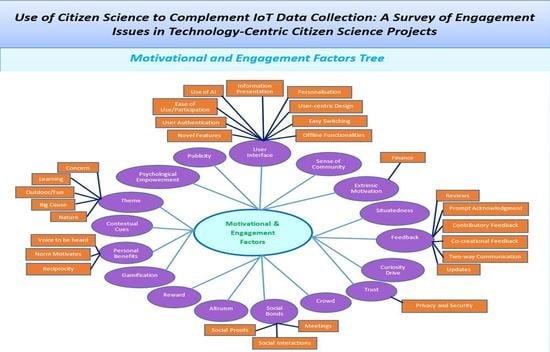Using Citizen Science to Complement IoT Data Collection: A Survey of Motivational and Engagement Factors in Technology-Centric Citizen Science Projects
Abstract
1. Introduction
2. Literature Review
2.1. Motivation and Engagement Factors in Technology-centric CS Projects
2.1.1. Theme/Cause
2.1.2. User Interface
2.1.3. Feedback
2.1.4. Reward
2.1.5. Personal Benefits
2.1.6. Social Bonds
2.1.7. Gamification
2.1.8. Sense of Community
2.1.9. Trust
2.1.10. Altruism
2.1.11. Curiosity Drive
2.1.12. Psychological Empowerment
2.1.13. Publicity
2.1.14. Situatedness
2.1.15. Extrinsic Motivation
2.1.16. Contextual Cues
2.1.17. Crowd Effect
2.2. Motivational and Engagement Factors Tree
2.3. Motivational and Engagement Factors Pareto Chart
3. Flooding Event Reporting Mobile Application: System Design and Methodology Using Motivational and Engagement Factors
3.1. Citizens Consultation and Application Conceptualisation
- “How the management agencies respond to our reports and how the data is used”?
- “We want to know what’s happening to our data”
- “We like to know what’s happening in the surrounding and the map view fulfil our knowledge gap”
3.2. Mobile App Design and Development
4. User Study
4.1. System Usability Scale (SUS)
4.2. SUS Feedback Analysis
5. Discussions and Limitations
6. Conclusions
Author Contributions
Funding
Institutional Review Board Statement
Informed Consent Statement
Acknowledgments
Conflicts of Interest
Appendix A. Summary of Citizens’ Feedback from the Workshop
- How do the management agencies respond to our reports and how the data is used?
- We want to know what’s happening to our data
- We like to know what’s happening in the surrounding and the map view fulfil our knowledge gap
- We would like to have an easy interface as the community has citizens from the elderly age group mostly.
- Does the application ask for personal details? If so what are the details?
- How long my personal data with the authority? How my data will be removed at my request?
- Can I upload the report from my home later after capturing the image from the site?
- What mobile specification is required to run the app?
- Can we point out the location of the incident through the application?
- Do this application run offline too?
- Can the app mask the human identification from the image?
- Who can view my report? Can anyone edit my report?
- Is this application available for all or limited to certain members of the community who are authorised by the local authority?
- Can this application be used from anywhere around the UK?
- Who will provide technical support or training to the app users?
- What if there is a higher risk to send the reports or not easy to go to the flooding site?
- Can we see the status of our reports through the app in terms of whether it has been being processed?
- Can I view reports from my area/community only?
- How to trust the report I view on the app? Is there any way to see the authentication of the report being presented?
- Is there any recognition of the user who continuously sends reports?
References
- Lim, C.; Kim, K.-J.; Maglio, P.P. Smart cities with big data: Reference models, challenges, and considerations. Cities 2018, 82, 86–99. [Google Scholar] [CrossRef]
- Appio, F.P.; Lima, M.; Paroutis, S. Understanding Smart Cities: Innovation ecosystems, technological advancements, and societal challenges. Technol. Forecast. Soc. Change 2019, 142, 1–14. [Google Scholar] [CrossRef]
- Voda, A.I.; Radu, L.-D. How can Artificial Intelligence Respond to Smart Cities Challenges? In Smart Cities: Issues and Challenges; 2019; pp. 199–216. Available online: https://www.sciencedirect.com/science/article/pii/B9780128166390000120?via%3Dihub (accessed on 31 January 2019).
- Aguilera, U.; Peña, O.; Belmonte, O.; López-de-Ipiña, D. Citizen-centric data services for smarter cities. Future Gener. Comput. Syst. 2017, 76, 234–247. [Google Scholar] [CrossRef]
- Aristeidou, M.; Herodotou, C. Online Citizen Science: A Systematic Review of Effects on Learning and Scientific Literacy. Citiz. Sci. 2020, 5, 1–12. [Google Scholar] [CrossRef]
- Shirk, J.L.; Ballard, H.L.; Wilderman, C.C.; Phillips, T.; Wiggins, A.; Jordan, R.; McCallie, E.; Minarchek, M.; Lewenstein, B.V.; Krasny, M.E.; et al. Public Participation in Scientific Research: A Framework for Deliberate Design. Ecol. Soc. 2012, 17, 29. [Google Scholar] [CrossRef]
- Conrad, C.C.; Hilchey, K.G. A review of citizen science and community-based environmental monitoring: Issue and oppertunities. Environ. Monit. Assess. 2011, 176, 273–291. [Google Scholar] [CrossRef] [PubMed]
- Fung, A. Putting the public back into governance: The challenges of citizen participation and its future. Public Adm. Rev. 2015, 75, 513–522. [Google Scholar] [CrossRef]
- Malone, T.W.; Klein, M. Harnessing collective intelligence to address global climate change. Innov. Technol. Gov. Glob. 2007, 2, 15–26. [Google Scholar] [CrossRef]
- Franzoni, C.; Sauermann, H. Crowd science: The organization of scientific research in open collaborative projects. Res. Policy 2014, 43, 1–20. [Google Scholar] [CrossRef]
- Davies, A.; Simon, J. The Value and Role of Citizen Engagement in Social Innovation. In A Deliverable of the Project TEPSIE; European Commission, DG Research: Brussels, Belgium, 2013. [Google Scholar]
- International Association for Public Participation. IAP2 Spectrum of Public Participation. 2007. Available online: https://iap2.org.au/resources/spectrum/ (accessed on 15 December 2020).
- Lwin, K.K.; Murayama, Y. Web-based GIS system for real-time field data collection using a personal mobile phone. J. Geogr. Inf. Syst. 2011, 3, 382. [Google Scholar] [CrossRef]
- The United Nations Economic Commission for Europe (UNECE). 1998. Available online: www.unece.org (accessed on 15 December 2020).
- Carolan, M.S. Science, Expertise, and the Democratization of the Decision-Making Process. Soc. Natl. Resour. 2006, 19, 661–668. [Google Scholar] [CrossRef]
- Haklay, M. Citizen Science and Volunteered Geographic Information: Overview and Typology of Participation. In Crowdsourcing Geographic Knowledge; Springer Science & Business Media: Berlin, Germany, 2013; pp. 105–122. [Google Scholar]
- Meijer, A.; Potjer, S. Citizen-generated open data: An explorative analysis of 25 cases. Gov. Inf. Q. 2018, 35, 613–621. [Google Scholar] [CrossRef]
- Jacobs, C.; Zipf, A. Completeness of citizen science biodiversity data from a volunteered geographic information perspective. Geo Spat. Inf. Sci. 2017, 20, 3–13. [Google Scholar] [CrossRef]
- Berntzen, L.; Johannessen, M.R.; Böhm, S.; Weber, C.; Morales, R. Citizens as sensors: Human sensors as a smart city data source. In Proceedings of the SMART 2018-The Seventh International Conference on Smart Systems, Devices and Technologies, Barcelona, Spain, 22–26 July 2018. [Google Scholar]
- Hart, A.; Stafford, R.; Goodenough, A.; Morgan, S. The role of citizen science and volunteer data collection in zoological research. Int. J. Zool. 2012, 2012, 105345. [Google Scholar] [CrossRef][Green Version]
- Clery, D. Galaxy Zoo volunteers share pain and glory of research. Science 2011, 333, 173–175. [Google Scholar] [CrossRef]
- Bonney, R.; Cooper, C.B.; Dickinson, J.; Kelling, S.; Phillips, T.; Rosenberg, K.V.; Shirk, J. Citizen Science: A Developing Tool for Expanding Science Knowledge and Scientific Literacy. BioScience 2009, 59, 977–984. [Google Scholar] [CrossRef]
- Danielsen, F.; Burgess, N.D.; Balmford, A.; Donald, P.F.; Funder, M.; Jones, J.P.; Alviola, P.; Balete, D.S.; Blomley, T.; Brashares, J. Local participation in natural resource monitoring: A characterization of approaches. Conserv. Biol. 2009, 23, 31–42. [Google Scholar] [CrossRef]
- Newman, G.; Wiggins, A.; Crall, A.; Graham, E.; Newman, S.; Crowston, K. The future of citizen science: Emerging technologies and shifting paradigms. Front. Ecol. Environ. 2012, 10, 298–304. [Google Scholar] [CrossRef]
- Mueller, M.; Tippins, D.; Bryan, L. The Future of Citizen Science. Democr. Educ. 2012, 20, 2. [Google Scholar]
- Rotman, D.; Preece, J.; Hammock, J.; Procita, K.; Hansen, D.; Parr, C.; Lewis, D.; Jacobs, D. Dynamic changes in motivation in collaborative citizen-science projects. In Proceedings of the ACM 2012 conference on computer supported cooperative work, Seattle, WA, USA, 11–15 February 2012; pp. 217–226. [Google Scholar]
- Davis, F.D. Perceived usefulness, perceived ease of use, and user acceptance of information technology. MIS Q. 1989, 13, 319–340. [Google Scholar] [CrossRef]
- Goodhue, D.L.; Thompson, R.L. Task-technology fit and individual performance. MIS Q. 1995, 19, 213–236. [Google Scholar] [CrossRef]
- Shirky, C. Cognitive Surplus: Creativity and Generosity in a Connected Age; Penguin: London, UK, 2010. [Google Scholar]
- Cooper, S.; Khatib, F.; Treuille, A.; Barbero, J.; Lee, J.; Beenen, M.; Leaver-Fay, A.; Baker, D.; Popović, Z. Predicting protein structures with a multiplayer online game. Nature 2010, 466, 756–760. [Google Scholar] [CrossRef]
- Bonney, R.; Shirk, J.L.; Phillips, T.B.; Wiggins, A.; Ballard, H.L.; Miller-Rushing, A.J.; Parrish, J.K. Next steps for citizen science. Science 2014, 343, 1436–1437. [Google Scholar] [CrossRef]
- Levac, D.; Colquhoun, H.; O’Brien, K.K. Scoping studies: Advancing the methodology. Implement. Sci. 2010, 5, 69. [Google Scholar] [CrossRef] [PubMed]
- Batson, C.D.; Ahmad, N.; Tsang, J.A. Four motives for community involvement. J. Soc. Issues 2002, 58, 429–445. [Google Scholar] [CrossRef]
- Lowry, C.S.; Fienen, M.N. CrowdHydrology: Crowdsourcing hydrologic data and engaging citizen scientists. GroundWater 2013, 51, 151–156. [Google Scholar] [CrossRef]
- Nov, O.; Arazy, O.; Anderson, D. Dusting for science: Motivation and participation of digital citizen science volunteers. In Proceedings of the 2011 iConference, Seattle, WA, USA, 8–11 February 2011; pp. 68–74. [Google Scholar]
- Ingensand, J.; Composto, S.; Nappez, M.; Produit, T.; Ertz, O.; Oberson, M.; Rappo, D. Challenges in VGI for scientific projects. PeerJ Preprints 2016, 4, 2167–9843. [Google Scholar]
- Phillips, T.B.; Ballard, H.L.; Lewenstein, B.V.; Bonney, R. Engagement in science through citizen science: Moving beyond data collection. Sci. Educ. 2019, 103, 665–690. [Google Scholar] [CrossRef]
- Jakositz, S.; Pillsbury, L.; Greenwood, S.; Fahnestock, M.; McGreavy, B.; Bryce, J.; Mo, W. Protection through participation: Crowdsourced tap water quality monitoring for enhanced public health. Water Res. 2020, 169, 115209. [Google Scholar] [CrossRef]
- Balestrini, M.; Diez, T.; Pólvora, A.; Nascimento, S. Mapping Participatory Sensing and Community-Led Environmental Monitoring Initiatives; European Commission: Brussels, Belgium, 2016. [Google Scholar]
- Hennig, S. Motivation and its consideration in participatory spatial data contribution. Prof. Geogr. 2020, 72, 238–252. [Google Scholar] [CrossRef]
- Guiney, M.S.; Oberhauser, K.S. Conservation volunteers’ connection to nature. Ecopsychology 2009, 1, 187–197. [Google Scholar] [CrossRef]
- Rambonnet, L.; Vink, S.C.; Land-Zandstra, A.M.; Bosker, T. Making citizen science count: Best practices and challenges of citizen science projects on plastics in aquatic environments. Mar. Pollut. Bullet. 2019, 145, 271–277. [Google Scholar] [CrossRef]
- Domroese, M.C.; Johnson, E.A. Why watch bees? Motivations of citizen science volunteers in the Great Pollinator Project. Biol. Conserv. 2017, 208, 40–47. [Google Scholar] [CrossRef]
- Jacobson, S.K.; Carlton, J.S.; Monroe, M.C. Motivation and satisfaction of volunteers at a Florida natural resource agency. J. Park Recreat. Adm. 2012, 30, 51–67. [Google Scholar]
- Bruyere, B.; Rappe, S. Identifying the motivations of environmental volunteers. J. Environ. Plan. Manag. 2007, 50, 503–516. [Google Scholar] [CrossRef]
- Land-Zandstra, A.M.; Devilee, J.L.; Snik, F.; Buurmeijer, F.; van den Broek, J.M. Citizen science on a smartphone: Participants’ motivations and learning. Public Underst. Sci. 2016, 25, 45–60. [Google Scholar] [CrossRef]
- Herodotou, C.; Aristeidou, M.; Sharples, M.; Scanlon, E. Designing citizen science tools for learning: Lessons learnt from the iterative development of nQuire. Res. Pract. Technol. Enhanc. Learn. 2018, 13, 4. [Google Scholar] [CrossRef]
- Hsu, Y.-C.; Cross, J.; Dille, P.; Tasota, M.; Dias, B.; Sargent, R.; Nourbakhsh, I. Smell Pittsburgh: Engaging Community Citizen Science for Air Quality. arXiv Prepr. 2019, arXiv:1912.11936. [Google Scholar]
- Zheng, F.; Tao, R.; Maier, H.R.; See, L.; Savic, D.; Zhang, T.; Chen, Q.; Assumpção, T.H.; Yang, P.; Heidari, B. Crowdsourcing methods for data collection in geophysics: State of the art, issues, and future directions. Rev. Geophys. 2018, 56, 698–740. [Google Scholar] [CrossRef]
- Flamm, R.O. Development and Launch of a Comprehensive Fish and Wildlife Reporting Mobile Application. J. Fish Wildl. Manag. 2019, 10, 676–690. [Google Scholar] [CrossRef]
- Pejovic, V.; Skarlatidou, A. Understanding Interaction Design Challenges in Mobile Extreme Citizen Science. Int. J. Hum. Comput. Interact. 2020, 36, 251–270. [Google Scholar] [CrossRef]
- Luna, S.; Gold, M.; Albert, A.; Ceccaroni, L.; Claramunt, B.; Danylo, O.; Haklay, M.; Kottmann, R.; Kyba, C.; Piera, J. Developing Mobile Applications for Environmental and Biodiversity Citizen Science: Considerations and Recommendations. In Multimedia Tools and Applications for Environmental & Biodiversity Informatics; 2018; pp. 9–30. Available online: https://link.springer.com/chapter/10.1007/978-3-319-76445-0_2 (accessed on 20 June 2018).
- Salim, F.; Haque, U. Urban computing in the wild: A survey on large scale participation and citizen engagement with ubiquitous computing, cyber physical systems, and Internet of Things. Int. J. Hum. Comput. Stud. 2015, 81, 31–48. [Google Scholar] [CrossRef]
- Pulli, P.; Antoniac, P. User Interface. U.S. Patent 6,771,294, 2004. [Google Scholar]
- May, A.; Ross, T. The design of civic technology: Factors that influence public participation and impact. Ergonomics 2018, 61, 214–225. [Google Scholar] [CrossRef]
- O’Brien, H.L.; Toms, E.G. What is user engagement? A conceptual framework for defining user engagement with technology. J. Am. Soc. Inf. Sci. Technol. 2008, 59, 938–955. [Google Scholar] [CrossRef]
- Golumbic, Y.N.; Fishbain, B.; Baram-Tsabari, A. User centered design of a citizen science air-quality monitoring project. Int. J. Sci. Educ. Part B 2019, 9, 195–213. [Google Scholar] [CrossRef]
- Wald, D.M.; Longo, J.; Dobell, A. Design principles for engaging and retaining virtual citizen scientists. Conserv. Biol. 2016, 30, 562–570. [Google Scholar] [CrossRef]
- Güiza, F.; Stuart, N. When citizens choose not to participate in volunteering geographic information to e-governance: A case study from Mexico. GeoJournal 2018, 83, 1151–1167. [Google Scholar] [CrossRef]
- Prestopnik, N.R.; Crowston, K. Citizen science system assemblages: Understanding the technologies that support crowdsourced science. In Proceedings of the 2012 iConference, Toronto, ON, Canada, 7–10 February 2012; pp. 168–176. [Google Scholar]
- Skarlatidou, A.; Hamilton, A.; Vitos, M.; Haklay, M. What do volunteers want from citizen science technologies? A systematic literature review and best practice guidelines. J. Sci. Commun. 2019, 18. [Google Scholar] [CrossRef]
- Johnson, E. Engaging with Our Crowd: A Study of Public Cultural Heritage Institutions Crowdsourcing Websites in Aotearoa, New Zealand. 2019. Available online: http://hdl.handle.net/10063/8200 (accessed on 17 December 2020).
- Sturm, U.; Tscholl, M. The role of digital user feedback in a user-centred development process in citizen science. J. Sci. Commun. 2019, 18, A03. [Google Scholar] [CrossRef]
- Weeser, B.; Kroese, J.S.; Jacobs, S.; Njue, N.; Kemboi, Z.; Ran, A.; Rufino, M.; Breuer, L. Citizen science pioneers in Kenya–A crowdsourced approach for hydrological monitoring. Sci. Total Environ. 2018, 631, 1590–1599. [Google Scholar] [CrossRef]
- Schneider, C.; von Briel, F. Crowdsourcing Large-Scale Ecological Monitoring: Identifying Design Principles to Motivate Contributors. In Building Sustainable Information Systems; Springer: Boston, MA, USA, 2013; pp. 509–518. [Google Scholar]
- Brandtner, P.; Auinger, A.; Helfert, M. Principles of human computer interaction in Crowdsourcing to foster motivation in the context of Open Innovation. In Proceedings of the International Conference on HCI in Business, Heraklion, Crete, Greece, 22–27 June 2014; pp. 585–596. [Google Scholar]
- Golumbic, Y.N.; Baram-Tsabari, A.; Koichu, B. Engagement and Communication Features of Scientifically Successful Citizen Science Projects. Environ. Commun. 2019, 14, 465–480. [Google Scholar] [CrossRef]
- Thiel, S.-K.; Reisinger, M.; Röderer, K.; Baldauf, M. Inclusive Gamified Participation: Who are we inviting and who becomes engaged? In Proceedings of the 52nd Hawaii International Conference on System Sciences, Maui, HI, USA, 8–11 January 2019.
- Nov, O.; Arazy, O.; Anderson, D. Scientists@Home: What drives the quantity and quality of online citizen science participation? PLoS ONE 2014, 9, e90375. [Google Scholar] [CrossRef] [PubMed]
- Kim, S.; Mankoff, J.; Paulos, E. Exploring barriers to the adoption of mobile technologies for volunteer data collection campaigns. In Proceedings of the 33rd Annual ACM Conference on Human Factors in Computing Systems, Seoul, Korea, 18–23 April 2015; pp. 3117–3126. [Google Scholar]
- Thiel, S.-K. A Review of introducing Game Elements to e-Participation. In Proceedings of the 2016 conference for E-democracy and open government (CeDEM), Krems, Austria, 18–20 May 2016; pp. 3–9. [Google Scholar]
- Yadav, P.; Darlington, J. Design guidelines for the user-centred collaborative citizen science platforms. arXiv Prepr. 2016, arXiv:1605.00910. [Google Scholar] [CrossRef]
- Preece, J. Citizen science: New research challenges for human-computer interaction. Int. J. Hum. Comput. Interact. 2016, 32, 585–612. [Google Scholar] [CrossRef]
- Reed, J.; Raddick, M.J.; Lardner, A.; Carney, K. An Exploratory Factor Analysis of Motivations for Participating in Zooniverse, a Collection of Virtual Citizen Science Projects. In Proceedings of the 2013 46th Hawaii International Conference on System Sciences, Wailea, Maui, HI, USA, 7–10 January 2013; pp. 610–619. [Google Scholar]
- Robson, C. Using Mobile Technology and Social Networking to Crowdsource Citizen Science. Ph.D. Thesis, University of California, Berkeley, CA, USA, 2012. [Google Scholar]
- Palacin-Silva, M.; Seffah, A.; Heikkinen, K.; Porras, J.; Pyhälahti, T.; Sucksdorff, Y.; Anttila, S.; Alasalmi, H.; Bruun, E.; Junttila, S. State-of-the Art Study in Citizen Observatories: Technological Trends, Development Challenges and Research Avenues; Finnish Environment Institute: Helsinki, Finland, 2016. [Google Scholar]
- Le Coz, J.; Patalano, A.; Collins, D.; Guillén, N.F.; García, C.M.; Smart, G.M.; Bind, J.; Chiaverini, A.; Le Boursicaud, R.; Dramais, G. Crowdsourced data for flood hydrology: Feedback from recent citizen science projects in Argentina, France and New Zealand. J. Hydrol. 2016, 541, 766–777. [Google Scholar] [CrossRef]
- Kosmala, M.; Wiggins, A.; Swanson, A.; Simmons, B. Assessing data quality in citizen science. Front. Ecol. Environ. 2016, 14, 551–560. [Google Scholar] [CrossRef]
- Alcatel-Lucent. The Missing Piece: Voice of Smart City Citizens. The Challenge for Governments and Private Organizations is to Determine How to Realize a Smart City Vision that Meets. 2013. (accessed on 17 December 2020).
- Brandeis, M.-N.W.; Carrera Zamanillo, M.I. Finding meaningful participation in volunteer geographic information and citizen science: A case comparison in environmental application. Cartogr. Geogr. Inf. Sci. 2016, 44, 539–550. [Google Scholar] [CrossRef]
- Leao, S.; Izadpahani, P. Factors motivating citizen engagement in mobile sensing: Insights from a survey of non-participants. J. Urban Technol. 2016, 23, 85–103. [Google Scholar] [CrossRef]
- Wehn, U.; Almomani, A. Incentives and barriers for participation in community-based environmental monitoring and information systems: A critical analysis and integration of the literature. Environ. Sci. Policy 2019, 101, 341–357. [Google Scholar] [CrossRef]
- Lowry, C.S.; Fienen, M.N.; Hall, D.M.; Stepenuck, K.F. Growing pains of crowdsourced stream stage monitoring using mobile phones: The development of CrowdHydrology. Front. Earth Sci. 2019, 7, 128. [Google Scholar] [CrossRef]
- Gharesifard, M.; Wehn, U. To share or not to share: Drivers and barriers for sharing data via online amateur weather networks. J. Hydrol. 2016, 535, 181–190. [Google Scholar] [CrossRef]
- Curtis, V. Motivation to participate in an online citizen science game: A study of Foldit. Sci. Commun. 2015, 37, 723–746. [Google Scholar] [CrossRef]
- Oliveira, T.; Barbeitos, I.; Calado, A. The Role of Intrinsic and Extrinsic Motivations in Sharing Economy Post-Adoption; Emerald Publishing Limited: Bingley, UK, 2021. [Google Scholar]
- Cappa, F.; Laut, J.; Porfiri, M.; Giustiniano, L. Bring them aboard: Rewarding participation in technology-mediated citizen science projects. Comput. Hum. Behav. 2018, 89, 246–257. [Google Scholar] [CrossRef]
- Cila, N.; Jansen, G.; Groen, M.; Meys, W.; den Broeder, L.; Kröse, B. Look! A healthy neighborhood: Means to motivate participants in using an app for monitoring community health. In Proceedings of the 2016 CHI Conference Extended Abstracts on Human Factors in Computing Systems, San Jose, CA, USA, 7–12 May 2016; pp. 889–898. [Google Scholar]
- Peddibhotla, N.B.; Subramani, M.R. Contributing to public document repositories: A critical mass theory perspective. Organ. Stud. 2007, 28, 327–346. [Google Scholar] [CrossRef]
- Martin, V.Y.; Greig, E.I. Young adults’ motivations to feed wild birds and influences on their potential participation in citizen science: An exploratory study. Biol. Conserv. 2019, 235, 295–307. [Google Scholar] [CrossRef]
- Pernat, N.; Kampen, H.; Jeschke, J.M.; Werner, D. Citizen science versus professional data collection: Comparison of approaches to mosquito monitoring in Germany. J. Appl. Ecol. 2021, 58, 214–223. [Google Scholar] [CrossRef]
- Bonney, R.; Ballard, H.; Jordan, R.; McCallie, E.; Phillips, T.; Shirk, J.; Wilderman, C.C. Public Participation in Scientific Research: Defining the Field and Assessing Its Potential for Informal Science Education. A CAISE Inquiry Group Report. 2009. Available online: https://eric.ed.gov/?id=ED519688 (accessed on 21 April 2021).
- Nov, O.; Arazy, O.; Anderson, D. Technology-mediated citizen science participation: A motivational model. In Proceedings of the Fifth International AAAI Conference on Weblogs and Social Media, Barcelona, Spain, 17–21 July 2011. [Google Scholar]
- Han, K.; Graham, E.A.; Vassallo, D.; Estrin, D. Enhancing motivation in a mobile participatory sensing project through gaming. In Proceedings of the 2011 IEEE Third International Conference on Privacy, Risk and Trust and 2011 IEEE Third International Conference on Social Computing, Security, Boston, MA, USA, 9–11 October 2011; pp. 1443–1448. [Google Scholar]
- Massung, E.; Coyle, D.; Cater, K.F.; Jay, M.; Preist, C. Using crowdsourcing to support pro-environmental community activism. In Proceedings of the SIGCHI Conference on Human Factors in Computing Systems, Paris, France, 27 April–2 May 2013; pp. 371–380. [Google Scholar]
- Asah, S.T.; Blahna, D.J. Practical implications of understanding the influence of motivations on commitment to voluntary urban conservation stewardship. Conserv. Biol. 2013, 27, 866–875. [Google Scholar] [CrossRef]
- Zhang, P. Toward a positive design theory: Principles for designing motivating information and communication technology. Adv. Apprec. Inq. 2007, 2, 45–74. [Google Scholar]
- Jennett, C.; Cox, A.; Guerrero, P.; Steed, A.; Mitra, N. Designing for Curiosity in Citizen Science. In Proceedings of the CHI 2017 Workshop “Designing for Curiosity”, Denver, CO, USA, 6–11 May 2017. [Google Scholar]
- Crowley, D.N.; Breslin, J.G.; Corcoran, P.; Young, K. Gamification of citizen sensing through mobile social reporting. In Proceedings of the 2012 IEEE International Games Innovation Conference, Rochester, NY, USA, 7–9 September 2012; pp. 1–5. [Google Scholar]
- Bowser, A.; Hansen, D.; He, Y.; Boston, C.; Reid, M.; Gunnell, L.; Preece, J. Using gamification to inspire new citizen science volunteers. In Proceedings of the First International Conference on Gameful Design, Research, and Applications, Toronto, ON, Canada, 2–4 October 2013; pp. 18–25. [Google Scholar]
- Greenhill, A.; Holmes, K.; Lintott, C.; Simmons, B.; Masters, K.; Cox, J.; Graham, G. Playing with science: Gamised aspects of gamification found on the online citizen science project-zooniverse. In Proceedings of the GAMEON’2014, Lincoln, UK, 9–11 September 2014; pp. 15–24. [Google Scholar]
- Iacovides, I.; Jennett, C.; Cornish-Trestrail, C.; Cox, A.L. Do games attract or sustain engagement in citizen science? A study of volunteer motivations. In Proceedings of the CHI’13 Extended Abstracts on Human Factors in Computing Systems, Paris, France, 27 April–2 May 2013; pp. 1101–1106. [Google Scholar]
- Tinati, R.; Luczak-Roesch, M.; Simperl, E.; Hall, W. Because science is awesome: Studying participation in a citizen science game. In Proceedings of the 8th ACM Conference on Web Science, Hannover, Germany, 22–25 May 2016; pp. 45–54. [Google Scholar]
- Newman, G.; Chandler, M.; Clyde, M.; McGreavy, B.; Haklay, M.; Ballard, H.; Gray, S.; Scarpino, R.; Hauptfeld, R.; Mellor, D. Leveraging the power of place in citizen science for effective conservation decision making. Biol. Conserv. 2017, 208, 55–64. [Google Scholar] [CrossRef]
- Paxton, M.; Benford, S. Experiences of participatory sensing in the wild. In Proceedings of the 11th International Conference on Ubiquitous Computing, Orlando, FL, USA, 30 September–3 October 2009; pp. 265–274. [Google Scholar]
- Goncalves, J.; Hosio, S.; Rogstadius, J.; Karapanos, E.; Kostakos, V. Motivating participation and improving quality of contribution in ubiquitous crowdsourcing. Comput. Netw. 2015, 90, 34–48. [Google Scholar] [CrossRef]
- Wilson, J.; Musick, M. Who cares? Toward an integrated theory of volunteer work. Am. Sociol. Rev. 1997, 694–713. [Google Scholar] [CrossRef]
- Balestrini, M.; Rogers, Y.; Hassan, C.; Creus, J.; King, M.; Marshall, P. A city in common: A framework to orchestrate large-scale citizen engagement around urban issues. In Proceedings of the 2017 CHI Conference on Human Factors in Computing Systems, Denver, CO, USA, 6–11 May 2017; pp. 2282–2294. [Google Scholar]
- Hsu, Y.-C. Designing Interactive Systems for Community Citizen Science. Ph.D. Thesis, Carnegie Mellon University, Pittsburgh, PA, USA, 2018. [Google Scholar]
- Ganzevoort, W.; van den Born, R.J.G.; Halffman, W.; Turnhout, S. Sharing biodiversity data: Citizen scientists’ concerns and motivations. Biodivers. Conserv. 2017, 26, 2821–2837. [Google Scholar] [CrossRef]
- Unger, L.S. Altruism as a motivation to volunteer. J. Econ. Psychol. 1991, 12, 71–100. [Google Scholar] [CrossRef]
- Baruch, A.; May, A.; Yu, D. The motivations, enablers and barriers for voluntary participation in an online crowdsourcing platform. Comput. Hum. Behav. 2016, 64, 923–931. [Google Scholar] [CrossRef]
- Wasko, M.M.; Faraj, S. Why should I share? Examining social capital and knowledge contribution in electronic networks of practice. MIS Q. 2005, 29, 35–57. [Google Scholar] [CrossRef]
- Quinn, A.J.; Bederson, B.B. Human computation: A survey and taxonomy of a growing field. In Proceedings of the SIGCHI Conference on Human Factors in Computing Systems, Vancouver, BC, Canada, 7–12 May 2011; pp. 1403–1412. [Google Scholar]
- Balestrini, M.; Diez, T.; Marshall, P.; Gluhak, A.; Rogers, Y. IoT community technologies: Leaving users to their own devices or orchestration of engagement? EAI Endorsed Trans. Internet Things 2015, 1, 7. [Google Scholar] [CrossRef]
- Silvia, P.J. Curiosity and Motivation. In The Oxford Handbook of Human Motivation; Oxford University Press: Oxford, UK, 2012; pp. 157–166. [Google Scholar]
- Jennett, C.; Kloetzer, L.; Schneider, D.; Iacovides, I.; Cox, A.; Gold, M.; Fuchs, B.; Eveleigh, A.; Methieu, K.; Ajani, Z. Motivations, learning and creativity in online citizen science. J. Sci. Commun. 2016, 15, A05. [Google Scholar] [CrossRef]
- Rotto, L.I. Curiosity, Motivation, and “Flow” in Computer-Based Instruction. 1994. Available online: https://www.learntechlib.org/p/78711/ (accessed on 16 December 2020).
- Webster, J.; Ahuja, J.S. Enhancing the design of web navigation systems: The influence of user disorientation on engagement and performance. MIS Q. 2006, 30, 661–678. [Google Scholar] [CrossRef]
- Zimmerman, M.A.; Rappaport, J. Citizen participation, perceived control, and psychological empowerment. Am. J. Community Psychol. 1988, 16, 725–750. [Google Scholar] [CrossRef]
- Zimmerman, M.A. Taking aim on empowerment research: On the distinction between individual and psychological conceptions. Am. J. Community Psychol. 1990, 18, 169–177. [Google Scholar] [CrossRef]
- Emaldi, M.; Aguilera, U.; López-de-Ipiña, D.; Pérez-Velasco, J. Towards citizen co-created public service apps. Sensors 2017, 17, 1265. [Google Scholar] [CrossRef] [PubMed]
- Goncalves, J.; Kostakos, V.; Karapanos, E.; Barreto, M.; Camacho, T.; Tomasic, A.; Zimmerman, J. Citizen motivation on the go: The role of psychological empowerment. Interact. Comput. 2014, 26, 196–207. [Google Scholar] [CrossRef]
- Eskelinen, J. Citizen-Driven Innovation. In A Guidebook for City Mayors and Public Administrators; World Bank Publications: Herndon, VA, USA, 2015. [Google Scholar]
- Roberts, N. Public deliberation in an age of direct citizen participation. Am. Rev. Public Adm. 2004, 34, 315–353. [Google Scholar] [CrossRef]
- Raddick, M.J.; Bracey, G.; Gay, P.L.; Lintott, C.J.; Murray, P.; Schawinski, K.; Szalay, A.S.; Vandenberg, J. Galaxy zoo: Exploring the motivations of citizen science volunteers. arXiv Prepr. 2009, arXiv:0909.2925. [Google Scholar] [CrossRef]
- Simpson, R.; Page, K.R.; De Roure, D. Zooniverse: Observing the world’s largest citizen science platform. In Proceedings of the 23rd International Conference on World Wide Web, Seoul, Korea, 7–14 April 2014; pp. 1049–1054. [Google Scholar]
- West, S.E.; Pateman, R.M. Recruiting and retaining participants in citizen science: What can be learned from the volunteering literature? Citiz. Sci. Theory Pract. 2016. [Google Scholar] [CrossRef]
- Tweddle, J.C.; Robinson, L.D.; Pocock, M.; Roy, H.E. Guide to Citizen Science: Developing, Implementing and Evaluating Citizen Science to Study Biodiversity and The Environment in the UK; NERC/Centre for Ecology & Hydrology: Bailrigg, UK, 2012. [Google Scholar]
- Papas, R.K.; Logan, H.L.; Tomar, S.L. Effectiveness of a community-based oral cancer awareness campaign (United States). Cancer Causes Control 2004, 15, 121–131. [Google Scholar] [CrossRef]
- Tinati, R.; Luczak-Roesch, M.; Simperl, E.; Hall, W. An investigation of player motivations in Eyewire, a gamified citizen science project. Comput. Hum. Behav. 2017, 73, 527–540. [Google Scholar] [CrossRef]
- Palacin, V.; Gilbert, S.; Orchard, S.; Eaton, A.; Ferrario, M.A.; Happonen, A. Drivers of Participation in Digital Citizen Science: Case Studies on Järviwiki and Safecast. Citiz. Sci. Theory Pract. 2020, 5, 22. [Google Scholar] [CrossRef]
- Conway, M.A. Episodic memories. Neuropsychologia 2009, 47, 2305–2313. [Google Scholar] [CrossRef]
- Sellen, A.; Whittaker, S. Beyond total capture: A constructive critique of lifelogging. Commun. ACM 2010, 53, 70–77. [Google Scholar] [CrossRef]
- Goncalves, J.; Kostakos, V.; Hosio, S.; Karapanos, E.; Lyra, O. IncluCity: Using contextual cues to raise awareness on environmental accessibility. In Proceedings of the 15th International ACM SIGACCESS Conference on Computers and Accessibility, Bellevue, WA, USA, 21–23 October 2013; p. 17. [Google Scholar]
- Brooke, J. SUS-A quick and dirty usability scale. Usability Eval. Ind. 1996, 189, 4–7. [Google Scholar]
- Bangor, A.; Kortum, P.T.; Miller, J.T. An empirical evaluation of the system usability scale. Intl. J. Hum. Comput. Interact. 2008, 24, 574–594. [Google Scholar] [CrossRef]
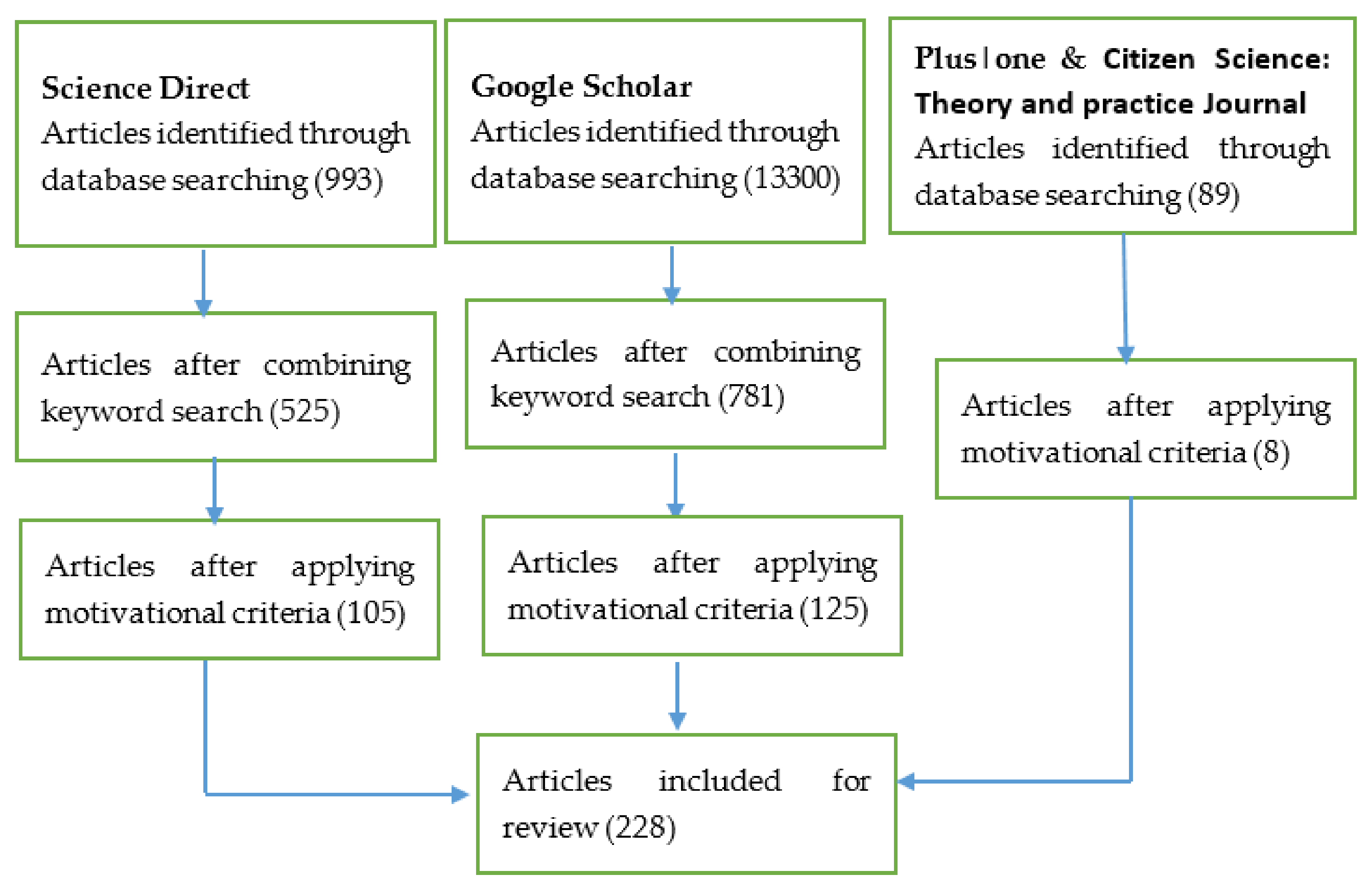
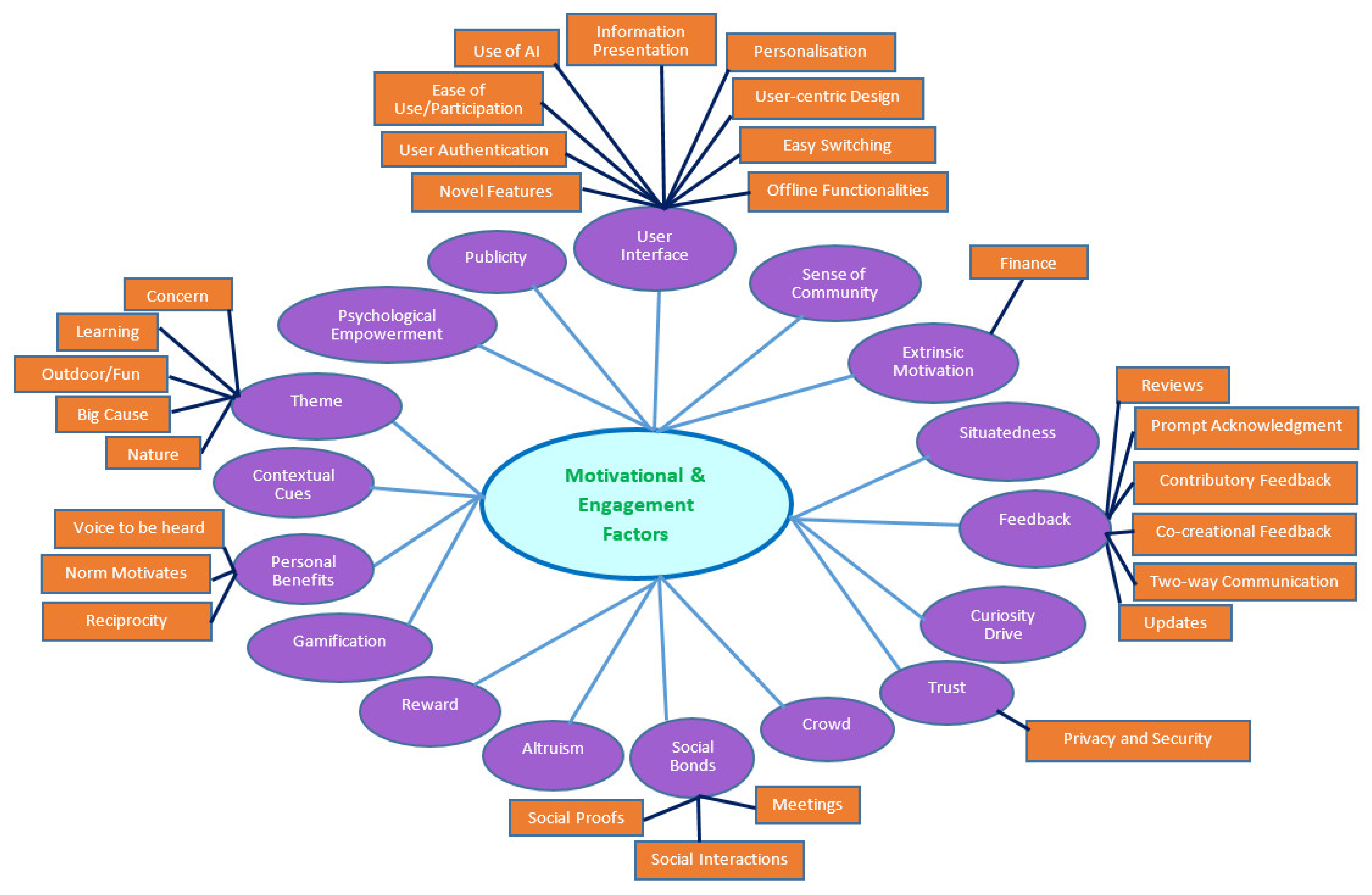
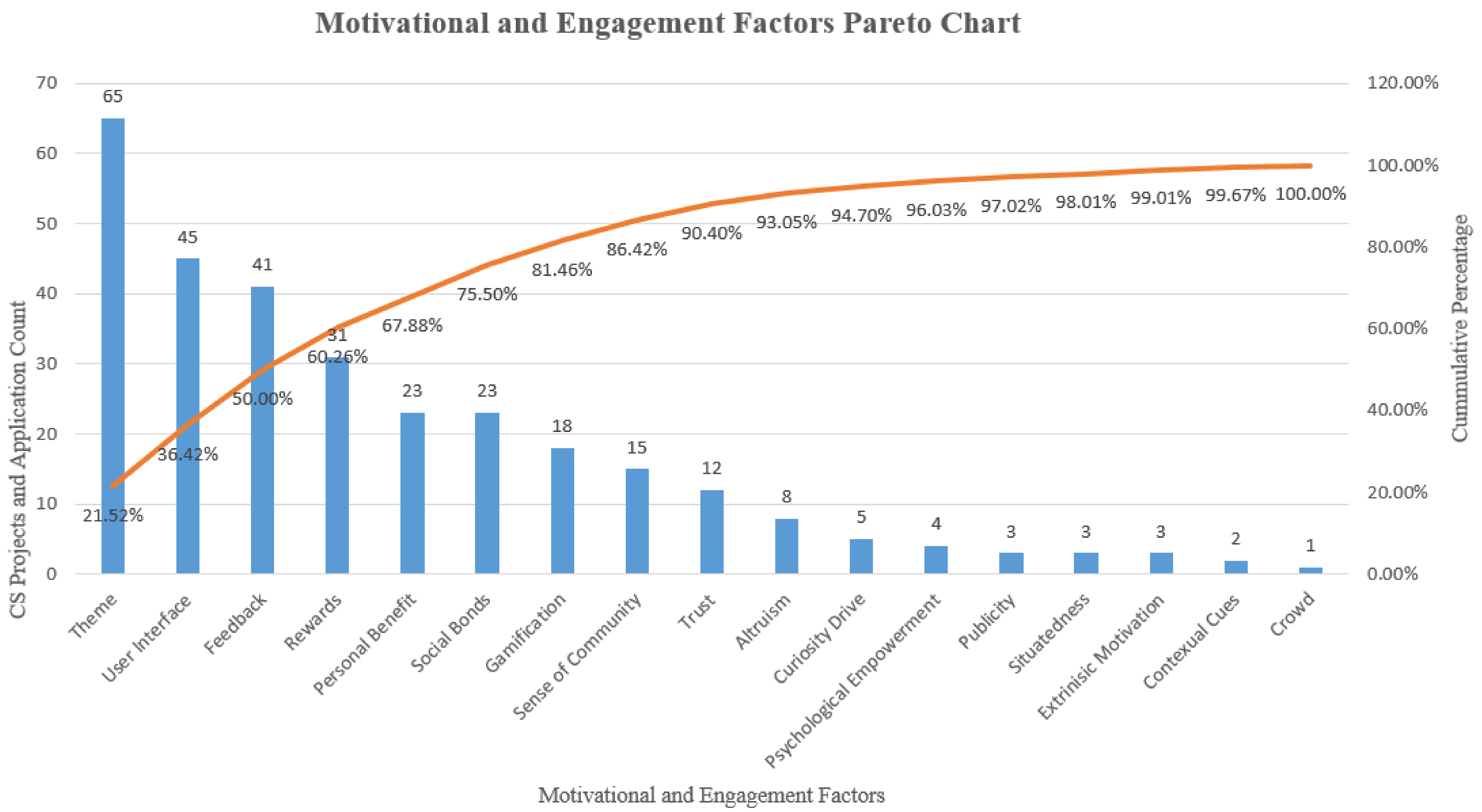
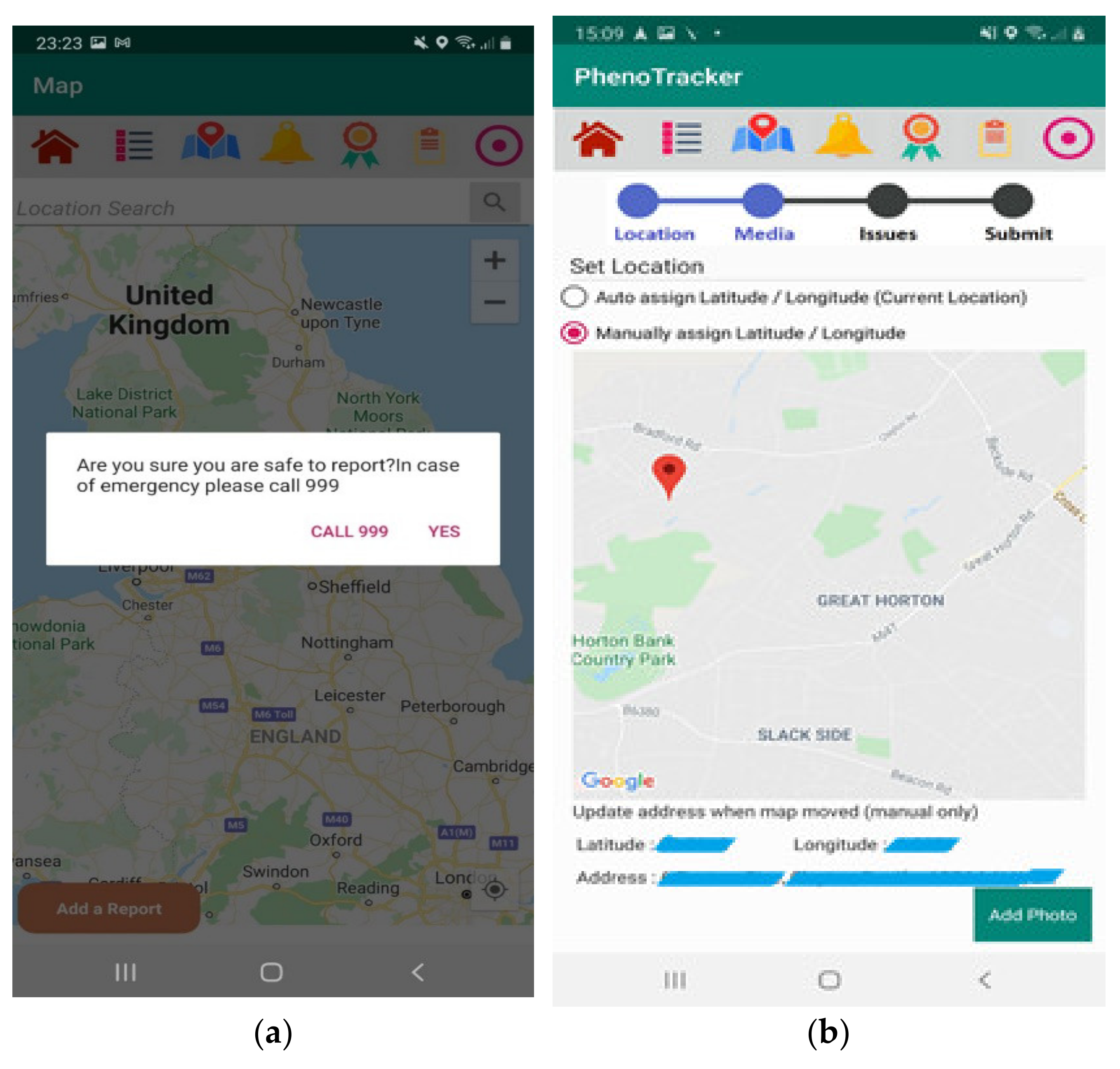
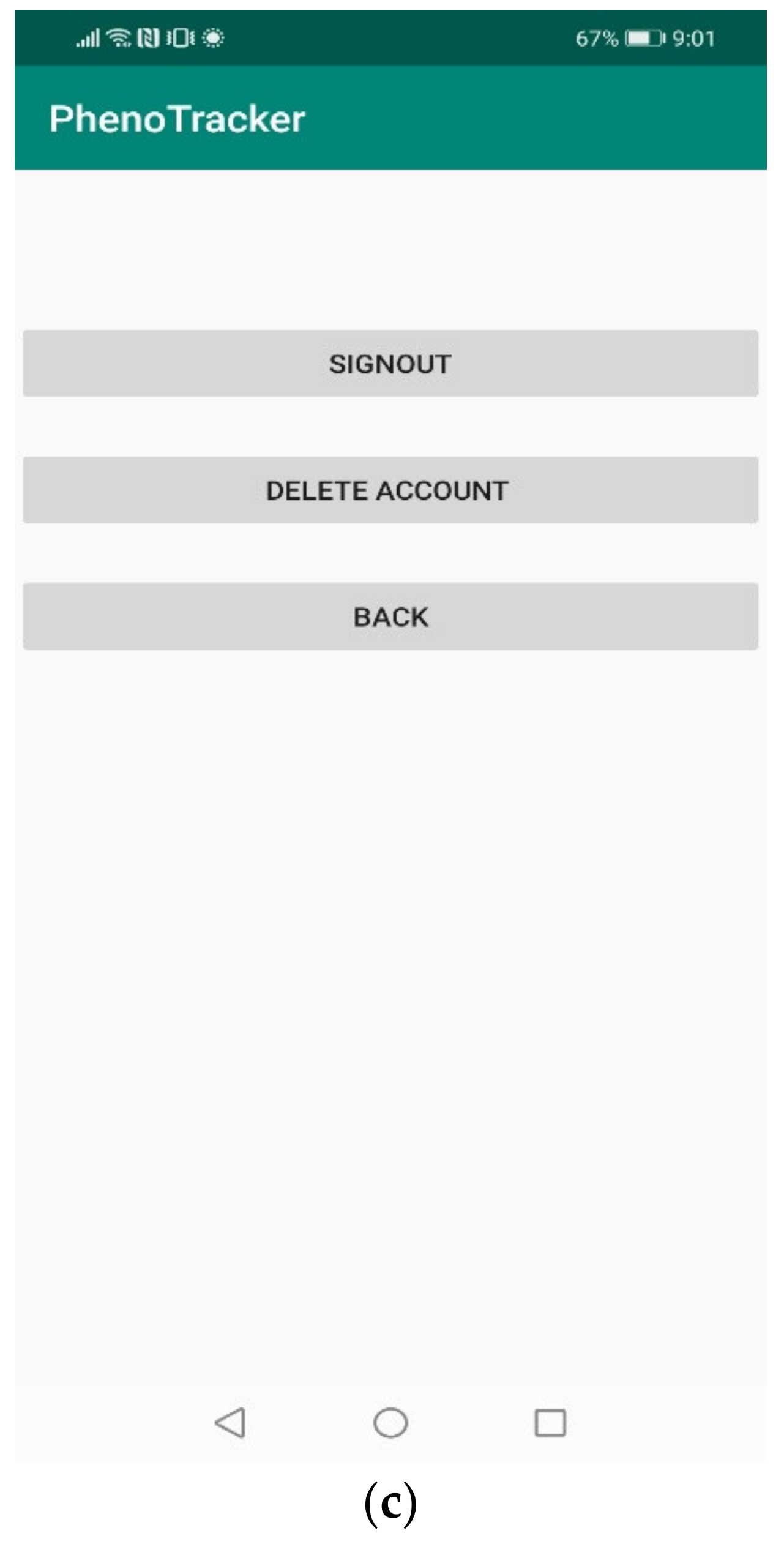
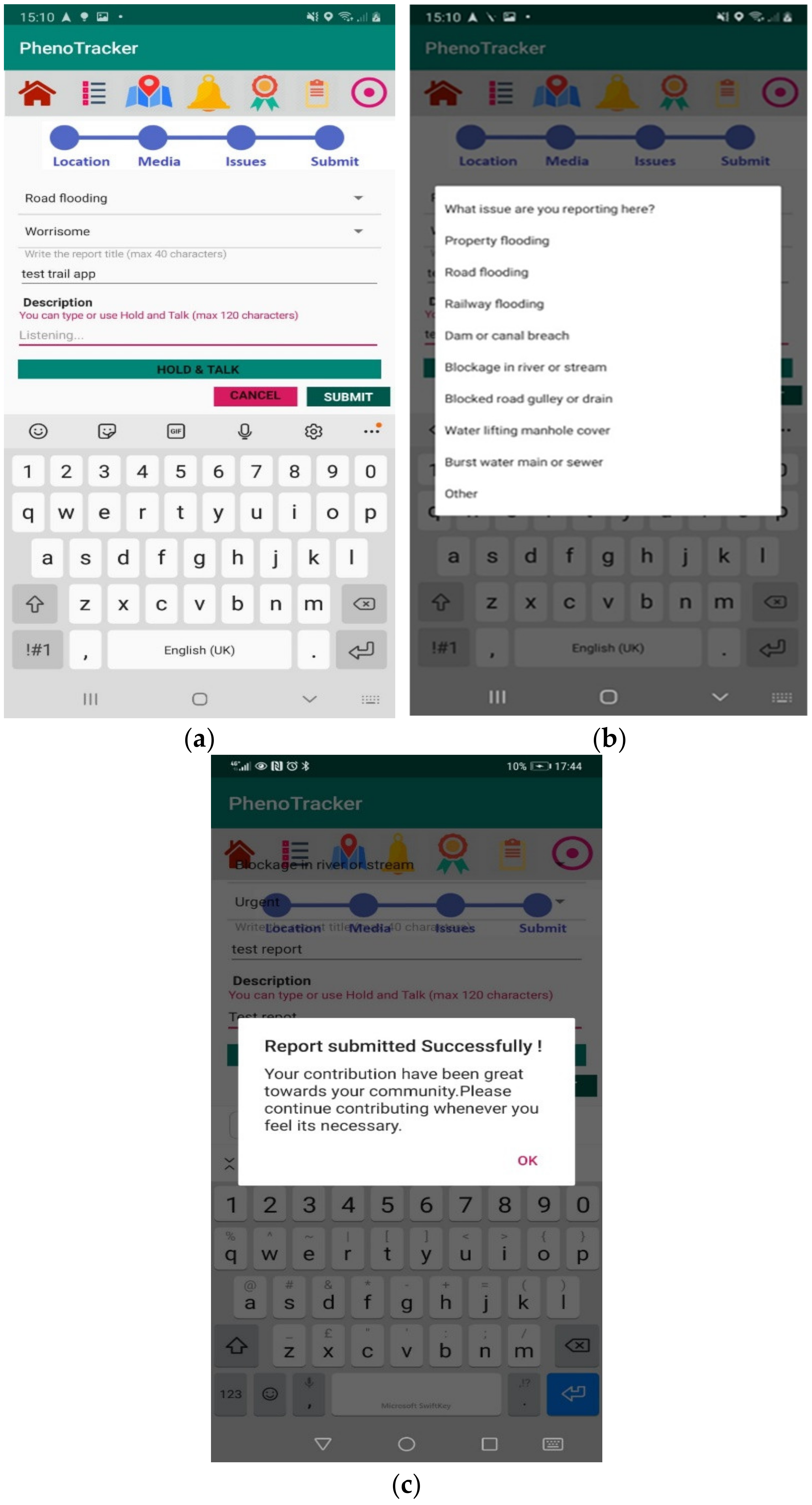


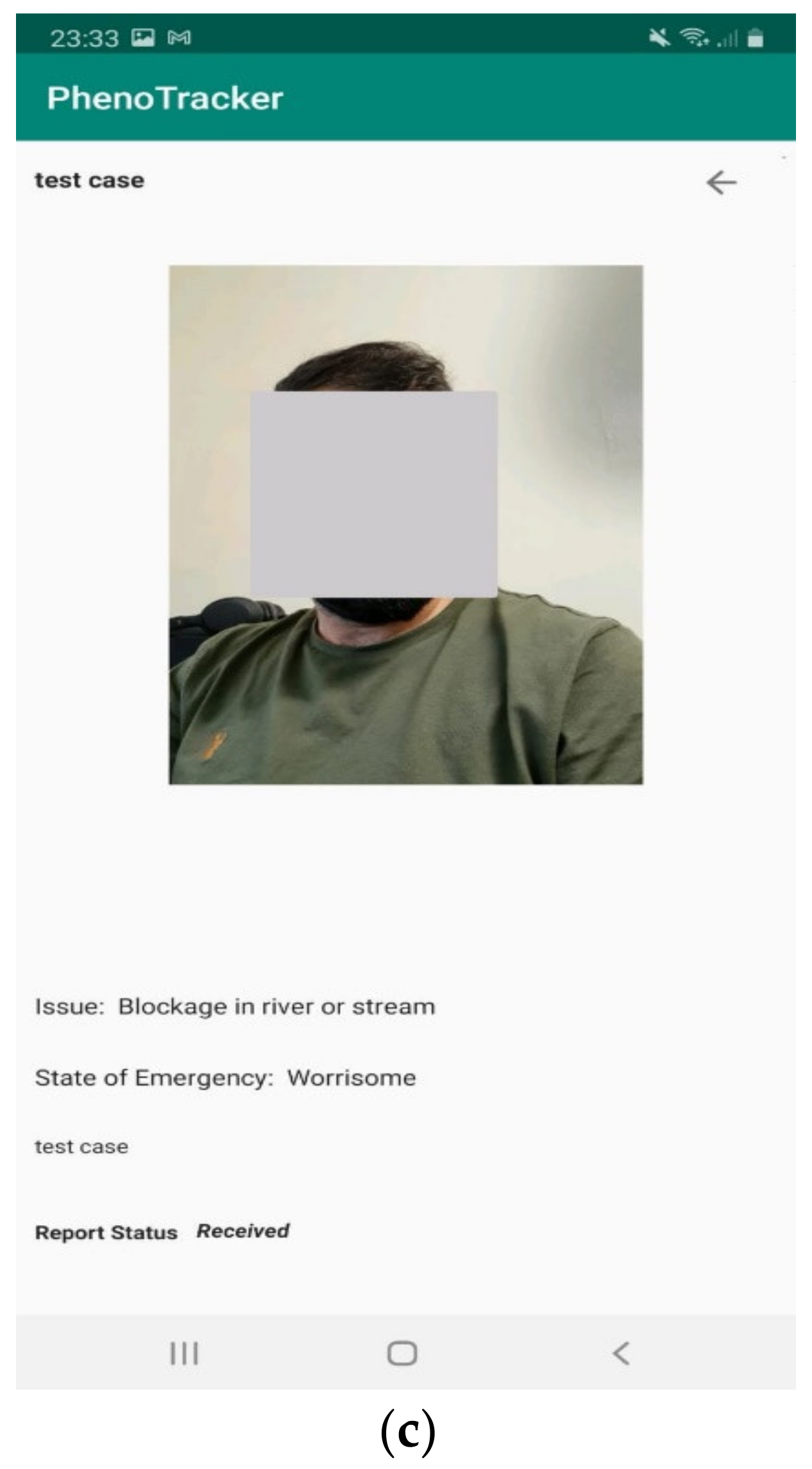
| Context | Keywords |
|---|---|
| Activity | “Motivation” OR “Participation” OR “Engagement” OR “Citizen Engagement” OR “Motivating Citizen” |
| Community Context | “Citizen Science” OR “Citizen Engagement” “Crowdsourced” OR ”Community Based“ OR “Volunteer Monitoring” |
| Environment Context | “Hydrology” OR “Flooding” OR “Citizen Science” |
| Technology Context | “Smartphone” OR “Mobile” OR “HCI” |
| Motivational and Engagement Factors | Papers | CS Projects | Number of Projects/Papers |
|---|---|---|---|
| Social Bonds | [37,39,62,68,69,71,75,76,90,94,95,96,108,109] | Great Pollinator Project, Feederwatch, iSpot, iNaturalist, Zooniverse, Luminous Blanket, Natural Fuse, Open Burble, Marling, Thingful, Pachube, Air Quality Egg, Safecast, Smart Citizen, Radiation watch, AoT, WeSenseIt, Onnocentive.com, ATIZO.com, IdeaStrom.com, CoCoRaHS eBird, Foldit Galaxy Zoo OPAL, Stardust, Stardust@homei, CWOP, BOINC, Budburst, Nestwatch, Monarch larva, Cocorahs.org and Gcmonitor | 32 projects, 14 papers |
| Feedback | [43,46,47,48,49,50,51,52,53,56,57,61,62,63,64,65,66,67,68,69,70,71,72,73,74,75,76] | Prourbe, iSpot, iNaturalist, Zooniverse, Sense the Air, Digital heritage, Natureblick, iSPEX, nQuire-it, Smell Pittsburgh, FWC Reporter, Hydrology monitoring Kenya, Onnocentive.com, ATIZO.com, IdeaStrom.com, CoCoRaHS eBird, Foldit, Galaxy Zoo OPAL, Gamified Mobile, CleanUp App, AirQuality app, Love your city, Biotracker DoGood and Täsä | 24 projects, 27 papers |
| Gamification | [62,68,71,73,81,84,88,91,96,98,108] | iSpot, iNaturalist, Zooniverse, Ctd Bristol, Luminous Blanket, Natural Fuse, Open Burble, Marling, Thingful, Pachube, Onnocentive.com, ATIZO.com, IdeaStrom.com, gamified mobile participation prototype, Stardust@homei, CWOP, BOINC, Love your city, Biotracker, DoGood, Täsä, Budburst and Kijk Mobile app | 23 projects, 11 papers |
| Sense of Community | [39,46,49,52,53,61,63,69,90,96,109] | Nestwatch, Monarch larva, Cocorahs.org, Gcmonitor, Budburst, CoCoRaHS eBird, Foldit Galaxy Zoo OPAL, WeSenseIt, Air Quality Egg, Safecast, Smart Citizen, Radiation watch, AoT, nQuire-it, Digital heritage, Wildlife Trackers, Pygmy, Hunter-gatherers forest monitoring in Brazil, Sense the Air, Creekwatch and Prourbe | 21 projects, 11 papers |
| Trust | [50,61,62,65,74,106,108] | Prourbe, iSpot, iNaturalist, Zooniverse, Luminous Blanket, Natural Fuse, Open Burble, Marling, Thingful, Pachube, Smell Pittsburgh, FWC Reporter, iNaturalist.org, iSpotnature.org, Floracaching, NatureNet, Welive and 2Loud | 18 projects, 7 papers |
| Theme | [34,35,36,37,38,39,40,42,48,49,50,51,52,53,65] | Great Pollinator, Creekwatch, Wildlife Trackers, Pygmy, hunter-gatherers forest monitoring in Brazil, iSPEX, nQuire-it, Smell Pittsburgh, FWC App, Crowd Hydrology, Stardust, Nestwatch, Monarch larva, Cocorahs.org, Gcmonitor, WeLive and Zooniverse | 17 projects, 15 papers |
| User Interface | [46,49,50,57,61,62,63,64,66,69,84,109] | Prourbe, iSpot, iNaturalist, Zooniverse, Sense the Air, Digital heritage, nQuire-it, Smell Pittsburgh, Air Quality Egg, Safecast, Smart Citizen, Radiation Watch, AoT, Hydrology monitoring Kenya, CoCoRaHS eBird, Foldit Galaxy Zoo OPAL and WeLive | 17 projects, 12 papers |
| Personal Benefits | [39,50,53,61,66,75,90,91] | Great Pollinator Project, Wildlife Trackers, Pygmy, hunter-gatherers forest monitoring in Brazil, Prourbe, Smell Pittsburgh, Hydrology monitoring Kenya, WeSenseIt, Foldit, iNaturalist.org, iSpotnature.org, Floracaching, NatureNet, Nestwatch, Monarch larva, Cocorahs.org, Welive and Gcmonitor | 17 projects, 8 papers |
| Reward | [37,39,49,52,66,68,71,76,84,85] | Prourbe, Creekwatch, nQuire-it, Hydrology Monitoring Kenya, Onnocentive.com, ATIZO.com, IdeaStrom.com, Stardust, Stardust@homei, CWOP, BOINC and Kijk Mobile app | 12 projects, 10 papers |
| Crowd | [53,108] | Luminous Blanket, Natural Fuse, Open Burble, Marling, Thingful and Pachube | 7 projects, 2 paper |
| Altruism | [48,53,75] | Wildlife Trackers, Pygmy, Hunter-gatherer forest monitoring in Brazil, Great Pollinator and iSPEX | 5 projects, 3 papers |
| Psychological Empowerment | [35,41,49,71] | nQuire-it, Stardust@homei, CWOP and OINC | 4 projects, 4 papers |
| Contextual Cues | [41,63] | iSpot, iNaturalist and Zooniverse | 3 projects, 2 papers |
| Curiosity Drive | [33,49] | nQuire-it | 1 project, 2 papers |
| Situatedness | [41,63] | Sense the Air | 1 project, 2 papers |
| Modified SUS Statements | Absolute Mean | Standard Deviation | Absolute Range |
|---|---|---|---|
| 1. I think that I would like to use this App frequently. | 3.8 | 1.30 | 2–5 |
| 2. I found this App unnecessarily complex. | 1.8 | 0.83 | 1–3 |
| 3. I thought this App was easy to use. | 4.0 | 0.71 | 3–5 |
| 4. I think that I would need assistance to be able to use this App. | 2.2 | 1.30 | 1–3 |
| 5. I found the various functions in this App were well-integrated | 4.2 | 0.83 | 3–5 |
| 6. I thought there was too much inconsistency in this App. | 2.2 | 1.30 | 1–4 |
| 7. I would imagine that most people would learn to use this App very quickly. | 4.4 | 0.90 | 3–5 |
| 8. I found this App very cumbersome/awkward to use | 2.6 | 1.52 | 1–4 |
| 9. I felt very confident using this App | 4.0 | 0.71 | 3–5 |
| 10. I needed to learn a lot of things before I could get going with this App. | 2.6 | 1.14 | 1–4 |
Publisher’s Note: MDPI stays neutral with regard to jurisdictional claims in published maps and institutional affiliations. |
© 2021 by the authors. Licensee MDPI, Basel, Switzerland. This article is an open access article distributed under the terms and conditions of the Creative Commons Attribution (CC BY) license (https://creativecommons.org/licenses/by/4.0/).
Share and Cite
Ali, M.U.; Mishra, B.K.; Thakker, D.; Mazumdar, S.; Simpson, S. Using Citizen Science to Complement IoT Data Collection: A Survey of Motivational and Engagement Factors in Technology-Centric Citizen Science Projects. IoT 2021, 2, 275-309. https://doi.org/10.3390/iot2020015
Ali MU, Mishra BK, Thakker D, Mazumdar S, Simpson S. Using Citizen Science to Complement IoT Data Collection: A Survey of Motivational and Engagement Factors in Technology-Centric Citizen Science Projects. IoT. 2021; 2(2):275-309. https://doi.org/10.3390/iot2020015
Chicago/Turabian StyleAli, Muhammad Uzar, Bhupesh Kumar Mishra, Dhavalkumar Thakker, Suvodeep Mazumdar, and Sydney Simpson. 2021. "Using Citizen Science to Complement IoT Data Collection: A Survey of Motivational and Engagement Factors in Technology-Centric Citizen Science Projects" IoT 2, no. 2: 275-309. https://doi.org/10.3390/iot2020015
APA StyleAli, M. U., Mishra, B. K., Thakker, D., Mazumdar, S., & Simpson, S. (2021). Using Citizen Science to Complement IoT Data Collection: A Survey of Motivational and Engagement Factors in Technology-Centric Citizen Science Projects. IoT, 2(2), 275-309. https://doi.org/10.3390/iot2020015






